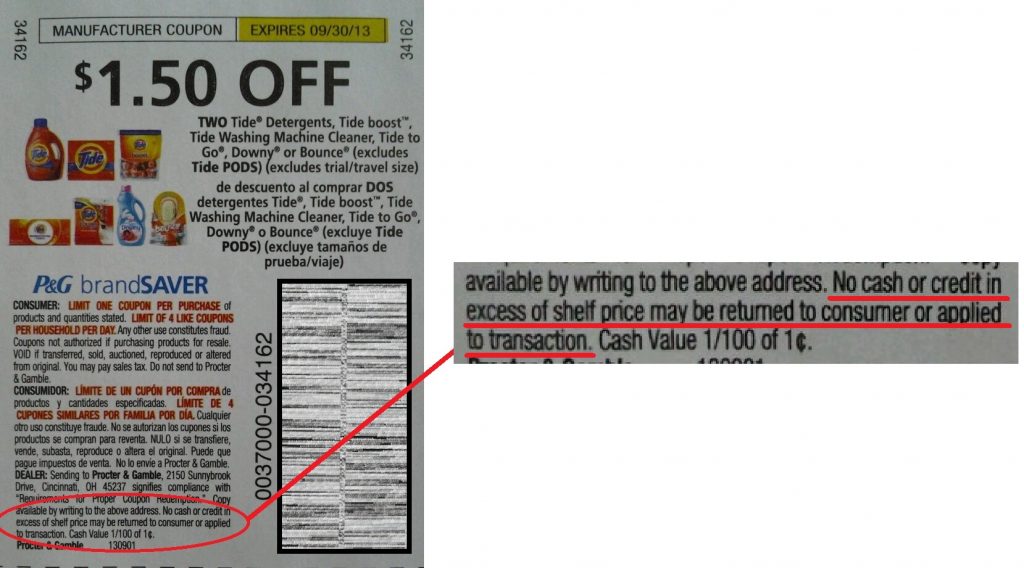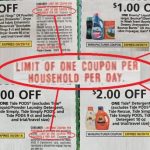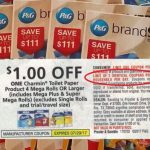
Over the past month or so, sharp-eyed couponers have been all abuzz about new wording recently added to Procter & Gamble coupons that appears to take aim at overage – the cash back you can score at some stores, if your coupon is worth more than the price of the product you’re using it on. Turns out, the wording isn’t really new at all, and overage has yet to go extinct. But that’s not stopping P&G from trying.
“No cash or credit in excess of shelf price may be returned to consumer or applied to transaction,” reads the fine print. P&G has actually been experimenting with such wording for more than a year, sneaking it onto some, particularly higher-value, coupons since at least the summer of 2012. But over the past couple of months, couponers finally started to notice and the word began to spread, as P&G began adding the wording to virtually all of its insert coupons, even (somewhat laughably) its notoriously low-value 25-cent off Bounty and Charmin coupons.
But the wording completely contradicts the coupon policies of some retailers – including the biggest one of them all. “If coupon value exceeds the price of the item, the excess may be given to the customer as cash or applied toward the basket purchase,” reads Walmart’s coupon policy.
So in the case of such a conflict, who wins? And what exactly is P&G trying to accomplish here – the end of overage as we know it?
P&G is finally offering some answers, though unfortunately, the explanation makes it all about as clear as mud.
“The intent of most coupons is to cover up to the actual price of the product. Hence, overage is an unusual situation and consumers should not expect to receive cash back on the purchase of a product,” a P&G spokesperson told Coupons in the News.
So are retailers that do allow overage, expected to instead adjust down the value of these P&G coupons? “Policies on overage vary by retailer,” was the response, “additionally, retailer practices may differ from store to store.”
Ok then – so if retailers stick to their own coupon policy and allow overage with these P&G coupons, will they be considered in violation of the terms and conditions and risk not getting reimbursed? “We know that the great majority of consumers and retailers will use P&G coupons under the terms and conditions stated on each coupon.”
Hmmm, so then if a couponer uses a P&G coupon, has the full value taken off according to the retailer’s coupon policy, and fails to request that the cashier kindly adjust down the value of the coupon so as not to receive any illicit overage, is the shopper then in violation of the terms and conditions printed on the coupon? “We understand that consumers will use every available, legitimate tool to maximize their savings. It’s a win-win situation for all – retailers, manufacturers, consumers – when you purchase a product on sale using a coupon and obtain even more savings!”
Okay, we don’t seem to be getting anywhere here.
Walmart did not respond to a request on how it planned to square its own overage policy with P&G’s conflicting overage policy. But the key word in Walmart’s coupon policy is “may” – as in, “excess may be given to the customer.” That gives individual stores and managers some leeway – and, as any Walmart couponer knows, its coupon policy is often open to interpretation by whatever store, cashier or manager you happen to run into.
The real question is whether P&G is trying to torpedo the coupon policies of overage-allowing stores, expecting them to fall in line and start banning the practice altogether – or whether its fine print regarding overage is just another vaguely unenforceable rule designed to act as a deterrent. The wording “Limit Of 4 Like Coupons Per Household Per Day”, for example, is designed to prevent shoppers from overdoing it and clearing shelves – but the P&G police aren’t exactly going to haul you in if you use three of those coupons, and another member of your family inadvertently uses a couple more at another store later that day. That being the case, neither are they likely to come after a retailer who fails to circumvent its own coupon policy and adjust down a $2 coupon on a $1.95 item.
But there’s a reason P&G might be particularly averse to overage. It has some high-priced items and, therefore, some high-value coupons that many have taken advantage of – either legitimately, or completely unethically. The company could not have been pleased back in the day, when loophole-seeking shoppers used some of P&G’s higher-value coupons on lower-priced trial sized items – those $10 Crest Whitestrips coupons with no size restrictions come to mind. After P&G added “Excludes Trial/Travel Size” to most of its coupons, some unseemly shoppers just went ahead and used coupons like those Whitestrips offers on inexpensive Crest toothpaste instead, hoping the coupons would go through and they’d make out like a bandit.
So the overage-disallowing terminology could be perceived as a backup – a way to give retailers a heads up that even if a high-value coupon “works” on a lower-priced item, P&G wants cashiers to take a closer look at whether the product and the coupon even match at all.
But let’s go ahead and make one more attempt to get a straight answer from P&G – if an overage-allowing store violates its own coupon policy and adjusts down the value of a P&G coupon instead of allowing overage, and then submits the coupon for reimbursement and gets the full value of the coupon back, in violation of P&G’s own coupon policy, what then?
The answer: “When used properly, everyone benefits from couponing!”
Thanks for clearing that up.











Coupons are meant to come off the selling price of a product. Item sells for $2….a $3 coupon should be adjusted to $2. That is what the item sold for. You aren’t paying $3 for the item, so why should one expect to get $3 taken off when the item cost $2?
As for what happens when the coupon is submitted, the store writes the price down on the coupon that they put the coupon through for. Not the store’s problem if when it is processed at the clearinghouse that they get $3 back when they only put the coupon through for $2. So maybe it is time that manufacturers don’t resort to using machines to process the coupons.
How is it that no one seems to care when the stores write the coupon down to the item price and then proceed to get the full value of the coupon reimbursed to them (plus 8¢)? The coupons are processed by machines at huge clearing houses. No one looks at the handwritten note that the cashier put on the coupon changing it from $2 to 97¢. The store just gets the $2. I view this as fraud on the part of the stores that do not allow overage!!!
If one is in any of the secret Facebook groups for glitches (otherwise known as coupon abuse/misuse/fraud, and they know that, but they don’t see it that way), one will see that overages are paid out quite frequently to many who misuse coupons (finding that a coupon works on a trial size product, YET the coupon clearly states trial size is excluded). It also creates “monsters” out of customers. And I agree it should be stopped. Walmart in the U.S. doesn’t state much, but if one questioned Walmart in Canada, they would tell you that when this wording is on the coupon, the cashier would adjust the amount of the coupon to what the product sold for it the product cost is less than the coupon. Walmart’s policy was before this wording started getting put on coupons, and I wouldn’t be surprised if one day we do see something in the policy to state something about overages no longer applicable to coupons that state none to be given.
Eventually could see the day that coupons go bye-bye and something else is implemented in place that would stop the misuse/abuse of coupons.
How about I stop buying brand name products and go for the cheap dollar store generic stuff then and see what happens to their business?
Since when are procter and gamble coupons ever enough to create an overage??
Ok I look at it this way… Product is for 1.98 you have a 2.00/1 coupon… Doesn’t the retailer submit it to the manufacture for full value of the coupon? So in this case you are not getting the 2.00 if the store doesn’t pay overages and making $.02 off the consumer. I find that wrong. Just like BOGO Free coupons. I MAKE the retailer write how much they gave me on it. Not just give me 1.99 off a up to 3.99 coupon to claim 3.99 a different week when it is not on sale. So us couponers are not all the fault here. Try the retailers.
Here’s what i was wondering, when clairol made the supposed mistake, and we were able to use the coupon on on their other products, most say not including trial size and they didn’t have a hair dye trial size . Then why can’t we us other coupons on another product say tide for example that makes other products if they don’t have a trial size like clairol made herbal essence does that make sense
Diane did you get your answer because that is something I would like to know
Pingback: P&G Explains its Attempt to Ban Overage - Sort Of - WeUseCoupons.com
Susan, so I go to all this work to clip my coupons during the week and the store gets the overage and not me? That seems messed up! And I don’t think I’m entitled to anything other than what I put my time and effort in to. I don’t live off of the government. I have a hard working husband and I work hard as well as coupon on the side. Overage on things I buy is rare but when it does occur it should go to the consumer who spent time and money clipping coupons and coming to shop
Wholeheartedly agree with you Laura!
I agree with you. the overage should be passed on to the consumers.
Frankly, it shocks me that people expect to receive these overages. Isn’t getting the product for free enough? It’s so typical of the “something for nothing, take more than I’m entitled to, why should I work when I can take advantage of someone else” mentality that’s totally ruining our country.
It’s not that we “expect to receive these overages” because they are RARE. But why does the store get to expect the full face value (plus the handling fee they are paid) if they didn’t give me the full face value? I took the time to look for, clip, organize and plan my shopping trip. If I happen to get lucky enough to find a sale that when combined with a coupon gives me a few cents to apply to the rest of my basket should I not get that? I don’t see what that has to do with taking advantage of someone else. I’m not taking advantage of anyone. I’m using the tools the manufacturer and store supplies me with. This is not charity or welfare BTW.
I love how they totally avoided what is in my opinion, the biggest issue. Does the store get reimbursed for the full face value of the product even if it is adjusted down at the register. No one has ever been able to explain that to me especially when the cashier does not make any notation anywhere that he/she adjusted the coupon down so that leaves me to wonder how much the store is benefiting from not allowing overages!
from,my understanding,even if they mark it down they’ll still receive full value because the coupons r ran through machines that scan the bar code and give the value accordingly,only if the cashier marks through the barcode,then right amount on coupon,it will be processed manually since the coupon would have kicked out coupon, since the line through barcode would have made it unreadable.
if they really are that concerned over people getting overage from the coupons, why don’t they just change the coupons to say that you can receive up to….x amount off.